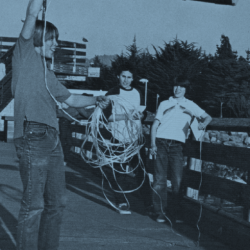Source Institutions
Source Institutions
Add to list Go to activity
Activity link broken? See if it's at the internet archive

In this outdoor activity, learners simulate an oil spill using popcorn (both oil and popcorn float on water), and estimate the spill's impact on the environment. Learners role play environmental impact experts who have been rushed to the scene of an oil spill. They must estimate how long it will take the spill to reach the shoreline of the body of water. This activity was developed for the seashore but may also be done at a lake, river or stream. One extension is to have learners try and keep the spill from spreading, using logs or floats, scooping the popcorn out of the water, or herding the oil into a pen with a giant squeegee.
- 30 to 45 minutes
- 45 to 60 minutes
- $10 - $20 per group of students
- Ages 8 - 14
- Activity, Field Trip, Lesson/Lesson Plan, Simulation
- English
Quick Guide
Materials List (per group of students)
- 25-meter length of light rope
- permanent marker
- plastic bucket or can with a metal handle (about 20 liters in volume)
- 50 cm x 50 cm piece of plastic window screen, nylon mosquito netting, or several 50 cm x 50 cm sheets of small mesh cheese cloth
- large rubber band, strip of inner tube, or elastic band that will fit snugly around the plastic bucket
- 25 meters of heavy twine or light rope marked off in 5-meter intervals
- 1 mini hacksaw, jigsaw, or serrated knife
- 20 liters of popped popcorn (plus another 20 liters for optional "Branching Out" extension)
- "Popcorn Slinger" Equipment Card
- Impact Challenge Cards
- pencils
- guides for identifying seashore organisms (optional)
- 1 tablespoon of salad oil or motor oil (optional)
- 1 cup or small bowl of water (optional)
Subjects
-
Earth and Space Science
-
Earth Structure
- Oceans and Water
-
Earth Structure
-
Engineering and Technology
-
Engineering
- Environmental Engineering
- Ocean Engineering
-
Engineering
-
Life Sciences
-
Diversity of Life
- Plants
- Animals
-
Ecology
- Human Impact
-
Diversity of Life
-
Mathematics
- Measurement
-
The Nature of Science
-
The Scientific Process
- Asking Questions
- Conducting Investigations
- Gathering Data
- Formulating Explanations
- Communicating Results
-
The Scientific Process
-
The Nature of Technology
-
Technology and Society
- Technology and the Environment
-
Technology and Society
Informal Categories
- Animals
- Nature and Environment
- Outdoor Activity
Audience
To use this activity, learners need to:
- see
- read
- be mobile
- touch
Learning styles supported:
- Involves teamwork and communication skills
- Uses STEM to solve real-world problems
- Involves hands-on or lab activities
Other
This resource is part of:
Access Rights:
- Free access
By:
Rights:
- All rights reserved, The Regents of the University of California, 1982
